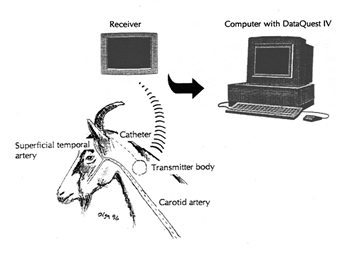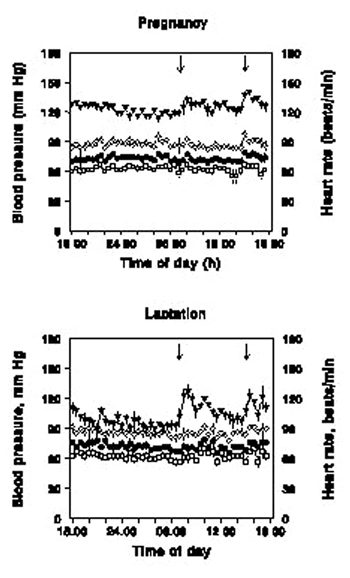Telemetry Research in Pregnant Goats
Studies on cardiovascular function are important from both psychological and physiological points of view. Changes in arterial blood pressure and heart rate give indirect indications of an animal's well-being, but the changes must be related to the animal's behavior and factors like time of day and reproductive period. Pregnancy and lactation are very demanding periods for the dairy goat. On-going telemetry research has enabled cardiac data associated with these changes such as blood pressure, ECG and heart rate, to be reliably captured in a chronic freely moving model.
Pregnancy lasts 5 months in the goat. The transmitters usually function well for 6-9 months and therefore we normally implant the transmitter during the second to third month of pregnancy. We use the TA11PA-D70 implant, which is also applied to dogs and non-human primates. In the latter species the catheter is implanted into the femoral artery, but we did not consider the femoral artery as ideal in the goat due to their big abdomen and large mammary gland. Instead, we use the superficial temporal artery. Under general anesthesia, the transmitter is placed laterally under the skin on the neck, and the catheter is tunnelled subcutaneously to the superficial temporal artery and further into the carotid artery (Fig. 1). Details of the operation has been published. The incision is made dorsally and the pocket for the transmitter body in a ventral direction. In our experience the transmitter is so heavy that it may interfere with healing of the wound if the incision is made ventrally of the pocket. Sometimes the pocket is filled with serosal fluid, which we have treated successfully with Hirudoid (Selena, Sundbyberg, Sweden; an ointment containing mucopolysacharide polysulphate).

Drawing of a goat. Figure shows the transmitter, the catheter tunnelled under the skin around the ear and into the superficial temporal artery and further into the carotid artery.
Since there are many activities going on during daytime, it has been of great value to be able to register the blood pressure and heart rate also during the night, when the goats are undisturbed (Fig. 2). Thereby, we have proved that heart rate, but not blood pressure, increases during goats' pregnancy. However, labor is accompanied by a stepwise increase in blood pressure reaching maximum at expulsion of the first kid. Our next step in making the most of utilizing telemetry in research was to combine telemetric recordings of arterial blood pressure and heart rate with echocardiography, and easily measure cardiac output.

24-hour recordings of systolic, mean, and diastolic blood pressures, and heart rate during late pregnancy (left) and lactation (right). Arrows denote feeding times. Note the difference in heart rate during pregnancy and lactation, and the increased heart rate in connection with feeding.
To learn more about this research contact: Kerstin Olsson, DVM, PhD, Professor Eva Hydbring-Sandberg, Agronom, PhD, Ass. Professor Department of Animal Physiology, Swedish University of Agricultural Sciences Uppsala, Sweden. Email:
mailto:kerstin.olsson@djfys.slu.se
Radiotelemetrically recorded blood pressure and heart rate changes in relation to plasma catecholamine levels during parturition in the conscious, unrestrained goat. Hydbring, E. MacDonald, E. K. Olsson Acta Physiol Scand 1997 161 295-302
Telemetric registration of heart rate and blood pressure in the same unrestrained goats during pregnancy, lactation and the non-pregnant nonlactating period. Hydbring, E. Cvek, K. K. Olsson Acta Physiol Scand 1999 165 135-141
A serial study of heart function during pregnancy, lactation and dry period in dairy goats using echocardiography. Olsson, K. Hansson, K. Hydbring, E. Winblad von Walter, L. J. Haggstrom. Exp Physiol. 2001
Physiological variables as indicators of stress and well-being. Hydbring, E. Acta Universitatis Agriculturae Sueciae 1998